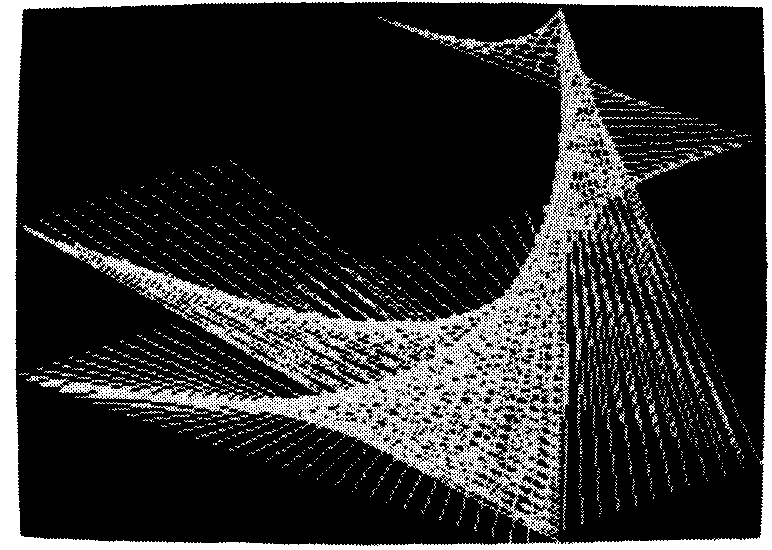
Some very beautiful patterns can be generated from a very simple set of rules. The following program creates a variety of unpredictable patterns, containing many curves, simply by drawing a series of line segments. The lines are drawn between two points which move in straight lines across the screen. When either point reaches the edge of the screen it is reflected, like a billiard ball. On reaching a certain complexity the pattern is undrawn, line by line, resulting in startling effects as parts of the pattern are eliminated before others.
Sample plot:
BBC Computer Version
The BBC Computer version uses integer variables for maximum speed, and the 4-colour graphics mode available on the Model A. Successive lines are drawn in different colours to give a rainbow effect.
10 REM ... Patterns 20 C%=1 30 DIM XX%(3),ZZ%(3),VV%(3),CC%(3),WW%(3)
Choose 160x256 4-colour graphics mode. Define logical colour zero (background) as physical colour 4 (blue), and logical colour 3 (white) as physical colour 2 (green); turn cursor off.
40 REPEAT MODE5 45 VDU19,0,4;0;19,3,2;0;23;&200A;0;0;0; 50 CC%(0)=1280:CC%(1)=1024:CC%(2)=CC%(0):CC%(3)=CC%(1) 60 FOR I%=0T03:XX%(I%)=ABSRND:VV%(I%)=ABSRND MOD4*8 70 XX%(I%)=XX%(I%) MOD CC%(I%):ZZ%(I%)=XX%(I%)+CC%(I%):NEXT 80 FOR G%=5T07 STEP2
Map two pairs of coordinates (ZZ(0),ZZ(1)) and (ZZ(2),ZZ(3)) onto screen window as (WW(0),WW(1)) and (WW(2),WW(3)).
90 REPEAT FOR I%=0TO3:ZZ%(I%)=ZZ%(I%)+VV%(I%) 100 WW%(I%)=ABS(ZZ%(I%)MOD(CC%(I%)*2)-CC%(I%)) 110 NEXT 120 C%=C%MOD3+1:GCOL0,C% 130 MOVE WW%(0),WWS(1):PLOTG%,WW%(2),WW%(3)
Keep plotting an different colours until return to starting coordinates, than repeat in black to clear picture.
140 UNTIL WW%(0)=XX%(0) AND WW%(1)=XX%(1) AND WW%(2)=XX%(2) AND WW%(3)=XX%(3) 150 NEXT:UNTIL 0
Variables:
CC%(0)..CC%(3) - Screen coordinates C% - Current colour 0-3 G% - Plotting code; G%=5 gives plottinq in white, and G%=7 gives plotting in black I - Index for arrays VVS(0)..VV%(3) - Vectors by which the two balls move at each stage WW%(0)..WW%(3) - Coordinates of two bouncing balls XX%(0)..XX%(3) - Starting coordinates of balls ZZ%(0)..ZZ%(3) - Coordinates of balls before mapping them to the screen; all positive
Atom Version
The Atom version uses the 256x192 graphics mode, and plots the lines in white.
10 REM ... PATTERNS ... 15 DIM XX3,ZZ3,VV3,CC3,WW3 20 DO CLEAR4 25 CC0=256;CC1=192;CC2=CC0;CC3=CC1 30 FOR I=0TO3;XXI=ABSRND;VVI=ABSRND%4*2 40 XXI=XXI%CCI;ZZI=XXI+CCI;NEXT 45 FOR G=5TO7 STEP2
Map two pairs of coordinates ZZ0,ZZ1 and (ZZ2,ZZ3) onto screen window as (WW0,WW1) and (WW2,WW3).
50 DO FOR I=0TO3;ZZI=ZZI+VVI 55 WWI=ABS(ZZI%(CCI*2)-CCI) 60 NEXT 65 MOVE WW0,WW1;PLOTG,WW2,WW3
Keep plotting in white until return to starting coordinates, then repeat in black to clear picture.
70 UNTIL WW0=XX0 AND WW1=XX1 AND WW2=XX2 AND WW3=XX3 90 NEXT;UNTIL 0
Variables:
CC0..CC3 - Screen coordinates G - Plotting code; G=5 gives plotting in white, and G=7 gives plotting in black I - Index for arrays VV0..VV3 - Vectors by which the two balls move at each stage WW0..WW3 - Coordinates of two bouncing balls XX0..XX3 - Starting coordinates of balls ZZ0..ZZ3 - Coordinates of balls before mapping them to the screen; all positive
Further Suggestions
A variant on these patterns can be obtained by replacing line 45 with:
45 FOR H%=0TO1;G%=6
or its equivalent on the Atom. The lines will then be drawn by inverting the screen.
The spacing of lines on the screen is determined by the values of VV%(0) to VV%(3) set in line 30. In the versions given above these values are constrained to be even, to limit the life of each pattern, but this can be altered to vary the spacing.